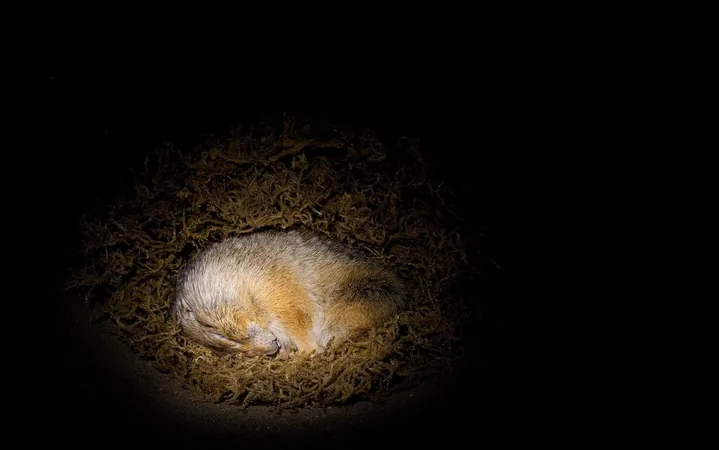
The Fascinating World of Hibernation: Why Humans Can't Yet Join the Club
2024-11-18
Author: Yan
Defining Hibernation: A State Between Life and Death?
Historically, hibernation was defined in the mid-19th century by Peter A Browne as "a natural, temporary, intermediate state, between life and death," stemming from environmental stresses like extreme temperatures or scarcity of food. Research shows that various mammals, from dormice and bears to bats and hedgehogs, display distinct hibernation patterns, challenging us to pin down a single definition. Scientists observe that individual species often hibernate in unique ways, making our understanding of the process complex yet fascinating.
Typical features of hibernation include a controlled reduction in metabolism, evidenced by slowed physiological and biochemical reactions. Sci-fi depictions often show humans in pods during "cryosleep," yet the science behind these fictional scenarios remains vague. As a sleep neuroscientist, I believe that unraveling the nature of sleep, in conjunction with hibernation, could unlock deeper insights into these states of being.
Current Interest: Why Hibernation Matters Now
The renewed fascination with hibernation comes at a pivotal moment in human history, as we grapple with global issues like climate change, pandemics, and the quest for sustainable living. Hibernation presents potential avenues for addressing these challenges, offering intriguing prospects ranging from clinical applications to revolutionizing space travel. Imagine hibernating through crises to awaken at a time of greater stability!
Recent studies classify hibernation into two types: seasonal hibernation, where animals undergo profound metabolic suppression lasting months (for instance, the thirteen-lined ground squirrel), and daily torpor, a shorter and less severe version seen in species like Djungarian hamsters. Both strategies allow animals to adapt cleverly to their environments, optimizing energy use, especially when faced with food shortages or declining temperatures.
Harmony with Nature: The Triggers and Mechanisms
Hibernation epitomizes an intricate dance with nature, dependent on environmental cues such as food scarcity and changing light levels. Animals build complex nests or store food, carefully timing their hibernation windows to avoid premature awakening that could lead to starvation.
In one study, researchers trained laboratory mice to run for food and observed that when the task became too strenuous, the mice wisely opted for a state of torpor rather than exerting extra energy. This clever choice highlights a survival strategy honed by millions of years of evolution.
Some scientists posit that our ancestors may have employed hibernation-like strategies during harsh winters. Yet, intriguingly, certain tropical species demonstrate hibernation in warmer conditions, suggesting that environmental pressures may extend beyond mere winter survival.
The Paradox: Humanity's Relationship with Hibernation
Despite our technological advancements, humans have yet to embrace the ability to hibernate. Our intelligence and resourcefulness—skills that have allowed us to adapt and thrive—might paradoxically hinder our potential affinity for hibernation. While some believe that we are "too smart" to enter a torpid state, the reality is that our progress has made us reliant on external resources for survival, diminishing our natural instinct to conserve energy.
Pop culture references to human hibernation or suspended animation abound, reflecting our fascination with this concept. From Mary Shelley's *Frankenstein* to modern science fiction narratives, the dream of human hibernation remains ever-present.
Attempts at Artificial Hibernation: A Cautious Exploration
The 1950s saw a surge of interest in artificial hibernation, with notable researchers like Henri Laborit exploring induced states of hypometabolism. Attempts to develop "hibernotherapy" aimed to mimic the protective physiological mechanisms of hibernating animals. However, these efforts have not led to significant breakthroughs, largely due to a lack of understanding of the biological processes involved.
Recent advancements have led to a better comprehension of the molecular underpinnings of both sleep and hibernation, with hopes that we can someday harness these mechanisms for human applications, especially in regard to space travel and a range of medical therapies, potentially offering breakthroughs for neurological disorders.
The Future of Human Hibernation: A Mysterious Path Ahead
One of the most profound mysteries remains—what is the relationship between sleep and hibernation? Research suggests that, in some species, hibernation can begin with a phase of sleep, raising provocative questions about the evolutionary origins of these states.
Continuing investigations into hibernating species may reveal critical insights that could one day offer us the keys to inducing a hibernation-like state in humans. The implications of mastering this ability could be transformative, not only for space exploration but also for addressing critical issues such as aging, metabolism, and overall health.
As we strive to understand why creatures around us have thrived with this invaluable skill, we might just find ourselves captivated by the notion that one day, hibernation might not be confined to the animal kingdom after all!

 Brasil (PT)
Brasil (PT)
 Canada (EN)
Canada (EN)
 Chile (ES)
Chile (ES)
 España (ES)
España (ES)
 France (FR)
France (FR)
 Hong Kong (EN)
Hong Kong (EN)
 Italia (IT)
Italia (IT)
 日本 (JA)
日本 (JA)
 Magyarország (HU)
Magyarország (HU)
 Norge (NO)
Norge (NO)
 Polska (PL)
Polska (PL)
 Schweiz (DE)
Schweiz (DE)
 Singapore (EN)
Singapore (EN)
 Sverige (SV)
Sverige (SV)
 Suomi (FI)
Suomi (FI)
 Türkiye (TR)
Türkiye (TR)